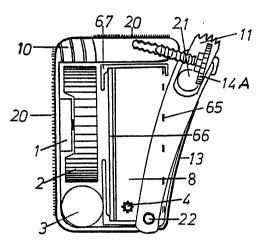Note: Claims are shown in the official language in which they were submitted.
PCT/??93/00089
C L A I M S
1. A personal portable air purifying apparatus with a carrying arrangement, e.g. including a
neck strap (11), for delivery of purified air to the users head/facial area,
c h a r a c t e r i z e d in that it comprises a filter/fan unit (8,2), affixed to the chest of the user,
said unit adapted to direct a concentrated stream of purified or conditioned air toward the user's
mouth and nose.
2. Apparatus according to claim 1,
c h a r a c t e r i z e d in that said filter/fan unit may also be kept in a stable and secure position
by a lower belt (fig. 4) included in the carrying arrangement, or for instance by the use of straps
or a tight fitting pocket or pouch in a suitable position.
3. Apparatus according to claim 1 or 2,
c h a r a c t e r i z e d in that said filter/fan unit is equipped with a rapid fastening arrangement,
for instance a Velcro attachment (20), for one or several further air influencing units to be
included as optional parts of the apparatus.
4. Apparatus according to claim 3,
c h a r a c t e r i z e d in that said further air influencing units comprise an ionizing unit (fig. 3
and fig. 8), an air cooling/humidifying unit (fig. 2 and fig. 7) and air current steering devices
(14A, 14B, 50-58, fig 5, fig. 6, 64).
5. Apparatus according to claim 4
c h a r a c t e r i z e d in that said air current steering devices include an electronic control
means (50-58), comprising detectors (52,53) for head movement of the user and controllable
devices (51,56,57,58) in or by an air outlet orifice for changing air fanning direction.
6. Apparatus according to claim 4,
c h a r a c t e r i z e d in that the air current steering devices include a manually adjustable
contraption for channeling a flow of air towards the desired area, for instance a manually
adjustable directing fin (fig. 6, 64) or swan's neck (fig. 5) of a flexible type, both having a base
attachable at the top of the apparatus by the use of a Velcro attachment (20), a magnet
attachment, or other rapid fastening arrangements.
7. Apparatus according to claim 4,
c h a r a c t e r i z e d in that the air current steering devices include a flexible and elastic air
duct (59), attached by means of a quick fastening arrangement, for instance a Velcro
WO 93/24168 PCT/NO93/00086
attachment (20), to the filter/fan unit (fig. 1 and 60), and a mask which covers the nose and
mouth (fig. 12), optionally also the eyes (fig. 13).
8. Apparatus according to one of the preceding claims,
c h a r a c t e r i z e d in that it includes a housing with an adjustable sloping rear hatch (fig.
1,13), adaptable to the users chest angle and posture, by e.g. an adjustment screw (14A),
notches or tooth edged adjustment pin (14B) arranged at the top or bottom of the apparatus for
adjustment of the angle of the rear hatch.
9. Apparatus according to one of claims 4-8,
c h a r a c t e r i z e d in that the ionizing unit (fig. 3) ionizes the departing air of the apparatus
and is easily attachable as a front part of the apparatus by means of a Velcro attachment (20),
magnet attachment, or another rapid fastening arrangement, by which the ionizing unit (fig. 3) is
placed as far away from the user's body as practically possible, optionally, by having a smaller
ionizing unit (fig. 8) influencing the air and being correspondingly attachable as a top part of the
apparatus, and that the ionizing units (fig. 3 and fig. 8) are adjustable (17) regarding the amount
of ionization, and optionally, directional adjustment of outgoing ions (18).
10. Apparatus according to one of claims 4-9,
c h a r a c t e r i z e d in that the cooling/humidifying unit (fig. 2 and fig. 7) includes a
thermoelectric cooling unit which can be fastened to the filter/fan unit by a Velcro attachment
(20), magnets or other quick fastening arrangement.
11. Apparatus according to one of claims 4-9,
c h a r a c t e r i z e d in that the cooling/humidifying unit (fig. 2 and fig. 7) comprises a cooling
means based on refrigerated material, for instance ice, dry ice or the like.
12. Apparatus according to claim 11,
c h a r a c t e r i z e d in that the cooling/humidifying unit (fig. 2) consists of an outside insulated
covering case (61), the interior cooling sheath (62) of the covering case having a shape
adapted to the exterior shape of the filter/fan unit or, optionally to the exterior shape of the
filter/fan unit when said further air influencing unit is attached thereto.
13. Apparatus according to one of claims 4-12,
c h a r a c t e r i z e d in that said filter/fan unit (fig. 1) includes a filter (8), optionally consisting
of several partial filters of various types arranged in series, close to an air inlet (63), and a fan
(2) which may be of a centrifugal or propeller type.
